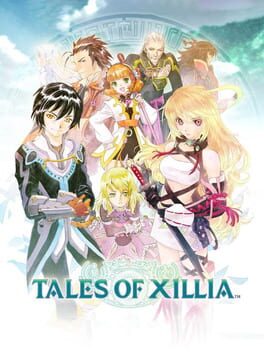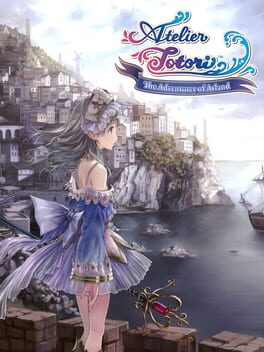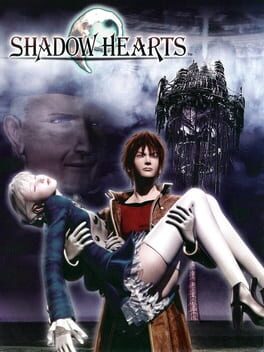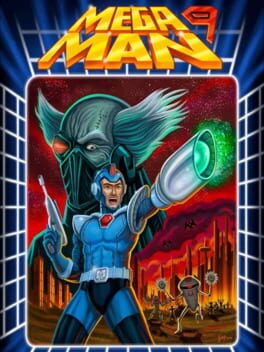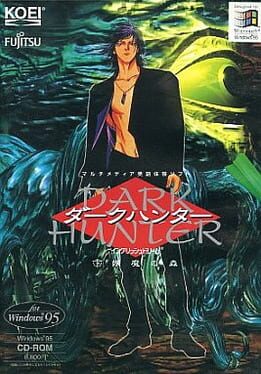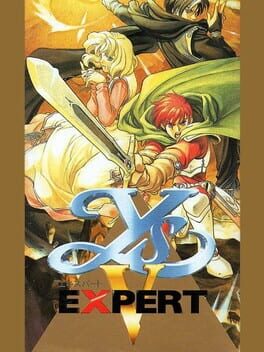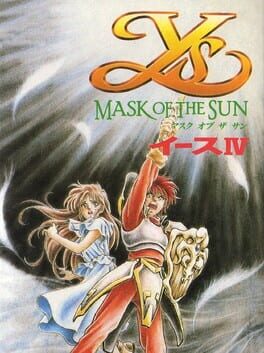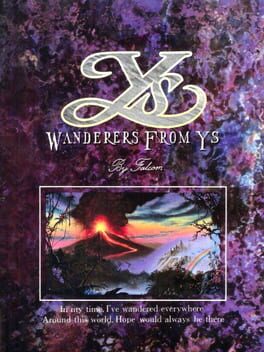PidgeGauss
Bio
Pidge Gauss in lotsa places~
These are my opinions on games I play.
I do not believe numerical values have much worth in ranking games when the review is right there, so I don't give star ratings.
Any opinion of mine in a review from 2017 or earlier is a "non-canon" one that I don't necessarily stand by anymore, and is really nothing more than a time capsule for how I felt at the time I played it.
Pidge Gauss in lotsa places~
These are my opinions on games I play.
I do not believe numerical values have much worth in ranking games when the review is right there, so I don't give star ratings.
Any opinion of mine in a review from 2017 or earlier is a "non-canon" one that I don't necessarily stand by anymore, and is really nothing more than a time capsule for how I felt at the time I played it.
Badges

Best Friends
Become mutual friends with at least 3 others

Loved
Gained 100+ total review likes

Popular
Gained 15+ followers

Elite Gamer
Played 500+ games

Noticed
Gained 3+ followers

Busy Day
Journaled 5+ games in a single day

Liked
Gained 10+ total review likes

Gamer
Played 250+ games

N00b
Played 100+ games

On Schedule
Journaled games once a day for a week straight
Favorite Games
646
Total Games Played
048
Played in 2024
000
Games Backloggd
Recently Played See More
Recently Reviewed See More
Continuing my journey through the 16-bit Ys games, next on the list was IV, a game I knew next to nothing about outside of it getting a remake on the Vita some decades later. Before even starting it, I was made very aware that this is one of two versions of the game, with the PC Engine version being developed by Hudson Soft and being completely different outside of sharing some similar plot beats, but this was the version I chose to play (if only because I already had all the stuff set up to play it and couldn’t be bothered to do the same for the PCE version X3). It took me about 8.5 or so hours to play through the Japanese version of the game on emulated hardware without abusing save states.
Mask of the Sun begins with Adol, our hero of Ys, finding a message in a bottle on the beach one day. The unfamiliar language inside, once translated for him by a friend, simply reads as a message to save a far-off land named “Celceta”. Adol quickly hops on a ship and sets off towards adventure in this land that apparently so badly needs saving. As was the case with Ys III, this is yet another good step forward in story writing for the series (despite effectively being written by completely different people). We have a more tightly paced story with better developed characters, and though I’d say we’re not quite at the level yet where we’re telling a story with deeper themes and messaging, we’re very nearly there! Granted, some of the messages you can read into Ys IV are less than positive in some respects, but they’re unintentional to the point that I don’t think they hurt the overall story too much ^^;. Oddly enough, even though this game has a ton of connective tissue to Ys I & II, it never mentions Ys III’s story at all. This isn’t really a problem, of course, but it was something that made me giggle nonetheless, especially with just how much this story so easily reads like an actual narrative sequel to Ys II, far more than Ys III ever did XD.
This goes beyond narrative as well, for Ys IV actually has a ton of connective tissue to I & II in its mechanics as well: Bump combat is back! I’ll admit, I was pretty bummed to see the return of bump combat, as I didn’t particularly enjoy it in Ys I & II, but I actually enjoyed it here a fair bit more than I did in those games. I understand that the overall premise (hitting enemies not dead-on deals damage where dealing direct bumps tends to just get yourself hurt) is basically the exact same way that bump combat works in I & II as well, but I noticed it far FAR more here than I ever did in those games. It’s an element of this game’s combat that’s far more unignorable than it ever was in those games due to how this game is balanced, and it makes for a much more challenging and interesting version of bump combat as a result. I found myself actually enjoying normal combat far more than I ever had in I & II, and it made combat feel a lot less overall pointless as a result.
Honestly, the mechanics overall are much stronger than I & II’s were, which I was very happy to see. Though there’s still some rough signposting here and there, it was never anything nearly so bad as plagued the far earlier adventure game designs of I & II. Though there were some things I had to look up in a guide at some points, they were almost always things that had just totally slipped my mind rather than things that I’d had no way of knowing the way those earlier games struggle with signposting. Level design on the whole was something I found markedly improved from the first two bump combat games, and the same goes for boss design as well.
These bosses felt far more actually designed than the first two games’ bosses usually did, and there was always some meaningful element of figuring out the strategy I needed rather than the old bump combat strategy I’d gotten used to where I just charged forward, hoped for the best, and usually won almost instantly. Magic is also back, and it depends on the sword you’re using instead of having bespoke spells you’re choosing from. I never found it super useful, as bump combat on its own was generally more than enough, but it was nice to have the option at least. I’m not sure this is going to convert anyone who already hated bump combat, and this game is certainly just as grindy as those old games were for having the right levels to take on the challenges you’re facing, but it was at least nice to see Ys return to that old formula and improve on it so significantly (despite the dev team being completely different x3).
The presentation is a bit simple for a mid-/late-life SFC game, but I still liked it quite a bit. Enemy, especially boss sprites, are well designed and cool looking, and the cutscene animations are very fun despite the relatively simple character and environment sprites. There’s a charm to things much like RPG Maker games would later have, with characters spinning on the spot or running around to indicate emotions in a way that I found very delightful, and some bespoke animations for certain cutscenes that had me giggling like a madman in my seat (like when Adol gets struck by lightning XD). The music is also unsurprisingly excellent. There were a lot of times where it almost felt like I’d stepped into a Mega Man X soundtrack all of a sudden, and I absolutely mean that as a compliment. An Ys game through and through, this game is packed with good and rockin’ tracks to fight monsters and witness drama, and that’s about all you could hope for, even in an Ys game not developed by Falcom themselves.
Verdict: Recommended. This is one that is very borderline between a hesitant and a normal recommendation, but I think it’s overall solid enough that I’d recommend it about as much as I would other less-than-perfect 16-bit action/adventure games I’ve played recently. Combat is quick and fun, boss battles are great, music is awesome, and the signposting is usually right on point. It’s honestly very confusing to me that this game has such a negative reputation. While I’d certainly believe the PCE version of Ys IV may indeed be better, I’d have a very hard time listing basically any way that the PCE version of Ys I & II is better than this game outside of that game’s CD-quality audio. This may not be the best of the Ys series, but I think that’s something you can really safely say about any of the Ys games made before Ys Origins. This game is good fun! Even if, as I said before, this probably won’t convert anyone who was already a non-believer in bump combat, I can still say with a good degree of confidence that, if you liked Ys I & II, I think you’ll probably really like this game too~.
Mask of the Sun begins with Adol, our hero of Ys, finding a message in a bottle on the beach one day. The unfamiliar language inside, once translated for him by a friend, simply reads as a message to save a far-off land named “Celceta”. Adol quickly hops on a ship and sets off towards adventure in this land that apparently so badly needs saving. As was the case with Ys III, this is yet another good step forward in story writing for the series (despite effectively being written by completely different people). We have a more tightly paced story with better developed characters, and though I’d say we’re not quite at the level yet where we’re telling a story with deeper themes and messaging, we’re very nearly there! Granted, some of the messages you can read into Ys IV are less than positive in some respects, but they’re unintentional to the point that I don’t think they hurt the overall story too much ^^;. Oddly enough, even though this game has a ton of connective tissue to Ys I & II, it never mentions Ys III’s story at all. This isn’t really a problem, of course, but it was something that made me giggle nonetheless, especially with just how much this story so easily reads like an actual narrative sequel to Ys II, far more than Ys III ever did XD.
This goes beyond narrative as well, for Ys IV actually has a ton of connective tissue to I & II in its mechanics as well: Bump combat is back! I’ll admit, I was pretty bummed to see the return of bump combat, as I didn’t particularly enjoy it in Ys I & II, but I actually enjoyed it here a fair bit more than I did in those games. I understand that the overall premise (hitting enemies not dead-on deals damage where dealing direct bumps tends to just get yourself hurt) is basically the exact same way that bump combat works in I & II as well, but I noticed it far FAR more here than I ever did in those games. It’s an element of this game’s combat that’s far more unignorable than it ever was in those games due to how this game is balanced, and it makes for a much more challenging and interesting version of bump combat as a result. I found myself actually enjoying normal combat far more than I ever had in I & II, and it made combat feel a lot less overall pointless as a result.
Honestly, the mechanics overall are much stronger than I & II’s were, which I was very happy to see. Though there’s still some rough signposting here and there, it was never anything nearly so bad as plagued the far earlier adventure game designs of I & II. Though there were some things I had to look up in a guide at some points, they were almost always things that had just totally slipped my mind rather than things that I’d had no way of knowing the way those earlier games struggle with signposting. Level design on the whole was something I found markedly improved from the first two bump combat games, and the same goes for boss design as well.
These bosses felt far more actually designed than the first two games’ bosses usually did, and there was always some meaningful element of figuring out the strategy I needed rather than the old bump combat strategy I’d gotten used to where I just charged forward, hoped for the best, and usually won almost instantly. Magic is also back, and it depends on the sword you’re using instead of having bespoke spells you’re choosing from. I never found it super useful, as bump combat on its own was generally more than enough, but it was nice to have the option at least. I’m not sure this is going to convert anyone who already hated bump combat, and this game is certainly just as grindy as those old games were for having the right levels to take on the challenges you’re facing, but it was at least nice to see Ys return to that old formula and improve on it so significantly (despite the dev team being completely different x3).
The presentation is a bit simple for a mid-/late-life SFC game, but I still liked it quite a bit. Enemy, especially boss sprites, are well designed and cool looking, and the cutscene animations are very fun despite the relatively simple character and environment sprites. There’s a charm to things much like RPG Maker games would later have, with characters spinning on the spot or running around to indicate emotions in a way that I found very delightful, and some bespoke animations for certain cutscenes that had me giggling like a madman in my seat (like when Adol gets struck by lightning XD). The music is also unsurprisingly excellent. There were a lot of times where it almost felt like I’d stepped into a Mega Man X soundtrack all of a sudden, and I absolutely mean that as a compliment. An Ys game through and through, this game is packed with good and rockin’ tracks to fight monsters and witness drama, and that’s about all you could hope for, even in an Ys game not developed by Falcom themselves.
Verdict: Recommended. This is one that is very borderline between a hesitant and a normal recommendation, but I think it’s overall solid enough that I’d recommend it about as much as I would other less-than-perfect 16-bit action/adventure games I’ve played recently. Combat is quick and fun, boss battles are great, music is awesome, and the signposting is usually right on point. It’s honestly very confusing to me that this game has such a negative reputation. While I’d certainly believe the PCE version of Ys IV may indeed be better, I’d have a very hard time listing basically any way that the PCE version of Ys I & II is better than this game outside of that game’s CD-quality audio. This may not be the best of the Ys series, but I think that’s something you can really safely say about any of the Ys games made before Ys Origins. This game is good fun! Even if, as I said before, this probably won’t convert anyone who was already a non-believer in bump combat, I can still say with a good degree of confidence that, if you liked Ys I & II, I think you’ll probably really like this game too~.
After finishing Ys I & II, I went straight to the sequel. I watched a let’s play of this game well over a decade ago, and that was actually probably my first exposure to Ys as a franchise. It didn’t look super incredible then, so I’ve never given it that much thought in the time since, but I figured since I was already thinking about Ys (and this is also a game my partner quite likes) that I might as well track down a way to play it and finally experience this game myself. It took me around 5 or so hours to beat the Japanese version of the game on emulated hardware.
Ys III takes place two years after the first Ys, with Adol going off with Dogi (a minor character from the first Ys) on more adventures around the world. Eventually, a fortune teller gives Dogi a disastrous fortune about his hometown of Redmont, and the two set off there at once. With such ominous beginnings, Adol quickly finds himself on a quest to save not just Redmont but all of Felghana from the great evil that lies just beneath its surface. Once again, this is a relatively early 90’s action/adventure game, so it’s not the best thing in the world, but we’re already seeing good steps from Ys I & II. The total cast is significantly smaller than that of those games, and those who are here generally have relatively far more active roles in the story instead of just being glorified dialogue flag triggers for Adol. It’s hardly going to give most SquareSoft games a run for their money, of course, but we’re taking firm steps in the right direction, and it’s a story I thought was good fun.
The actual gameplay of Ys III could hardly be more different while still being in the same action/adventure genre. Dead and buried is the old staple of bump combat, as now not only does Adol fight by swinging his sword with the attack button, but we’re not even a top-down game anymore! Ys III is a sidescrolling action/adventure game in the vein of something like Castlevania II or Zelda II, with everything from towns to dungeons navigated like that and having no overworld to speak of. This is sort of a double-edged sword. On the more negative end is that sidescrollers just have a lot less literal space to work with as adventure games. The world feels quite small compared to Ys I & II (even though it’s not terribly bigger or smaller), and the level design ends up feeling quite unimpressive as well.
On the other hand, however, I honestly far prefer the gameplay in this to the gameplay of Ys I & II. While the bosses still aren’t amazing and a lot of enemies are quite simple and similar to one another, needing to jump, duck, and swing your sword to fight stuff means that combat has far more depth, and I found it far more fun as a result. Sure, a lot of bosses are still a matter of mulch or be mulched, that more active element means you actually feel more accomplished for taking a boss down quick compared to the bump combat equivalent of just having vindication that you did enough grinding to see this through. Hit detection (especially on the penultimate and final bosses) is a bit wonky at times, but this game at the very least continues to have the same save anywhere system that the earlier Ys games has, so getting nuked down by a boss is still just a matter of entering the room and trying again until your strategy is more sound.
This game still has levels to grind for, sure, but the relative length of this game being shorter also comes with the levels being far faster to grind for too. I did maybe a combined hour or hour and a half of grinding in this (with the owls in the ruins being a particularly great place to reach max level quickly), and after that it was all smooth sailing. This game even has better signposting than the first two did as well, thankfully, and I didn’t get lost or need to look up where to go a single time~. Ys III is overall still a bit on the easy side (much like Ys I & II were if you kept on top of grinding), but the overall play style of this was something I ended up enjoying much more despite how much smaller an adventure this is.
Though we’re on a SNES and therefore lack the storage capacity for the voice acting or CD-quality sound that a PC Engine can boast, the presentation is still as good as ever. The graphics are a bit simple compared to some other SFC games, but environments are still nice and colorful, and enemies especially are very pretty and well designed. Though I’ve been told that other versions (such as the PCE CD version, naturally) have better music, the SFC is still a very capable machine, and this is still an Ys game, so the music still rocks as much as ever even though the gameplay has changed so much.
Verdict: Recommended. This is a game that I don’t think is honestly that much better than Ys Books I & II on paper, but the execution is done so much better that it ends up being much easier to recommend as a result. If you don’t mind a bit of jank and a bit of grinding at the start, this is a good fun action/adventure 16-bit adventure game. It’s not the best thing on the system, for sure, but it still manages to be good to play with good music, and it’ll make a fun thing to go through in a weekend if this is a retro genre you’re interested in (as I so very much am).
Ys III takes place two years after the first Ys, with Adol going off with Dogi (a minor character from the first Ys) on more adventures around the world. Eventually, a fortune teller gives Dogi a disastrous fortune about his hometown of Redmont, and the two set off there at once. With such ominous beginnings, Adol quickly finds himself on a quest to save not just Redmont but all of Felghana from the great evil that lies just beneath its surface. Once again, this is a relatively early 90’s action/adventure game, so it’s not the best thing in the world, but we’re already seeing good steps from Ys I & II. The total cast is significantly smaller than that of those games, and those who are here generally have relatively far more active roles in the story instead of just being glorified dialogue flag triggers for Adol. It’s hardly going to give most SquareSoft games a run for their money, of course, but we’re taking firm steps in the right direction, and it’s a story I thought was good fun.
The actual gameplay of Ys III could hardly be more different while still being in the same action/adventure genre. Dead and buried is the old staple of bump combat, as now not only does Adol fight by swinging his sword with the attack button, but we’re not even a top-down game anymore! Ys III is a sidescrolling action/adventure game in the vein of something like Castlevania II or Zelda II, with everything from towns to dungeons navigated like that and having no overworld to speak of. This is sort of a double-edged sword. On the more negative end is that sidescrollers just have a lot less literal space to work with as adventure games. The world feels quite small compared to Ys I & II (even though it’s not terribly bigger or smaller), and the level design ends up feeling quite unimpressive as well.
On the other hand, however, I honestly far prefer the gameplay in this to the gameplay of Ys I & II. While the bosses still aren’t amazing and a lot of enemies are quite simple and similar to one another, needing to jump, duck, and swing your sword to fight stuff means that combat has far more depth, and I found it far more fun as a result. Sure, a lot of bosses are still a matter of mulch or be mulched, that more active element means you actually feel more accomplished for taking a boss down quick compared to the bump combat equivalent of just having vindication that you did enough grinding to see this through. Hit detection (especially on the penultimate and final bosses) is a bit wonky at times, but this game at the very least continues to have the same save anywhere system that the earlier Ys games has, so getting nuked down by a boss is still just a matter of entering the room and trying again until your strategy is more sound.
This game still has levels to grind for, sure, but the relative length of this game being shorter also comes with the levels being far faster to grind for too. I did maybe a combined hour or hour and a half of grinding in this (with the owls in the ruins being a particularly great place to reach max level quickly), and after that it was all smooth sailing. This game even has better signposting than the first two did as well, thankfully, and I didn’t get lost or need to look up where to go a single time~. Ys III is overall still a bit on the easy side (much like Ys I & II were if you kept on top of grinding), but the overall play style of this was something I ended up enjoying much more despite how much smaller an adventure this is.
Though we’re on a SNES and therefore lack the storage capacity for the voice acting or CD-quality sound that a PC Engine can boast, the presentation is still as good as ever. The graphics are a bit simple compared to some other SFC games, but environments are still nice and colorful, and enemies especially are very pretty and well designed. Though I’ve been told that other versions (such as the PCE CD version, naturally) have better music, the SFC is still a very capable machine, and this is still an Ys game, so the music still rocks as much as ever even though the gameplay has changed so much.
Verdict: Recommended. This is a game that I don’t think is honestly that much better than Ys Books I & II on paper, but the execution is done so much better that it ends up being much easier to recommend as a result. If you don’t mind a bit of jank and a bit of grinding at the start, this is a good fun action/adventure 16-bit adventure game. It’s not the best thing on the system, for sure, but it still manages to be good to play with good music, and it’ll make a fun thing to go through in a weekend if this is a retro genre you’re interested in (as I so very much am).
Playing through Lagoon recently, it made me curious on just how it compares to the game its so clearly copying, Ys Books I & II. I’ve played through the DS remake of Ys I & II many years ago, but I’ve never actually so much as looked at the original version of the games. I then realized that I actually have a perfect way to play the contemporary versions of those games via my PC Engine Mini, and set right to work playing through them once I finished with Lagoon. It took me about 18 or 20 hours to play through the Japanese version of the game on my PCE Mini without abusing save states.
Ys Books I & II, as its name implies, is the first two Ys games back-to-back, as they are each one half of one larger story: Book I is our hero Adol unraveling the mystery of the tomes of Ys and climbing the Tower of Darm, and then Book II is him actually in the titular Ys and saving it from the great evil that besieges it. Being action/adventure games from the late-80’s, the writing isn’t exactly anything terribly impressive (it’s a bit too exposition heavy and the cast is a bit too packed with one-dimensional characters, for starters), but the voice acting this PCE CD version adds to the PC-88 originals definitely helps it stand out that much more. It’s highly improved by the remakes the story has gotten over the years, but it’s quite impressive for a game this old nonetheless.
The gameplay of Ys I & II is actually a little different between games, but the building blocks are the same, and they share the most important one anyhow: bump combat. Back when making games, especially on home computers, faced a lot more difficult technical hurdles, some games opted to forego an ability to swing your sword at things and instead just have combat decided by how you happened to run at your enemy and make contact with them. This collision-based combat has been since deemed “bump combat”, and while Ys is far from the first instance of it, it’s definitely one of the most famous.
That said, just because it’s historically interesting doesn’t really mean that it’s good, and I think that we’ve since moved away from bump combat for very good reasons. Your power in Ys is determined not just by what sword, shield, and armor you’re using, but also your level, as this game has light RPG-elements in how you get experience points from killing enemies. While there are actual mechanics to the bump combat here (it isn’t all random or stat-based), you and your enemies move so fast that you functionally don’t really have much reason to think of them most of the time. As long as you’re not standing still (in which case you will definitely take a very nasty hit), you’re bump combat-ing more or less correctly.
Ys II adds offensive magic that makes fighting bosses in particular feel far more like your choices actually matter, but Ys I has no such system to benefit from. Bump combat is neat in how fast and simple it is, sure, but it’s so simple that I ultimately felt myself questioning why it was even there in the first place. Especially given just how much grinding is necessary in these games, bump combat often just makes the “combat” feel like nothing but padding between boss fights, and those boss fights are pretty lousy too. Either you’re getting mulched because your stats/equipment aren’t high enough (or that boss has some really annoying gimmick that makes them awful to hit like the one in the mines), or you’re instantly mulching them because your stats are high enough. The final boss of Ys I and especially the final boss of Ys II are some stand outs as for how they really make you use some strategy and reflexes to dodge projectiles and such, but the combat and boss fights in both games are frankly really underwhelming compared to a lot of other action/adventure games we had by the late-80’s.
This wouldn’t be such an issue if the story were good or interesting, which it isn’t terribly, or the level/dungeon design were good, but that’s also sadly not the case. Both games (but especially Ys I) suffer from some really rough level design, and the signposting can make it absolutely maddening on where you’re actually meant to go next. Ys I is packed with necessary plot items hidden in all corners of its dungeons, and it’s very easy to make a wrong turn or just not realize one is there at all, so then you’re stuck wondering just what the heck you missed, wandering around for ages just trying to find some semblance of where to go. Ys II is thankfully far better in this regard, but both games have some pretty rough design in just how sprawling and maze-like their dungeons are, and with basically all enemies fighting the same way (it’s all just bump-to-win) too, it’s not like dungeons really feel all that different from one another anyhow outside of aesthetics. A lot of Ys I & II’s issues are far from unique to them for their era, and a lot of their issues come down to their large ambitions more than anything, but that’s cold comfort in current-year when those failed ambitions just make things frustrating more than they do fun or interesting a lot of the time.
Given that the aesthetics are from 1989, they’re really impressive and show off a ton of just what the PC Engine could do with its fancy CD tech! While they’ll hardly put later games in the 16-bit generation to shame, they’re both very impressive for the time and still pretty now. On that same note, the music is absolutely excellent. Lots of awesome, rocking tracks that underlie the action at hand really well. If anything, they’re so awesome that the action should kick things up a couple of notches just to keep up! XD
Verdict: Hesitantly Recommended. As much as I ragged on this game for a lot of reasons, I did still quite enjoy it at the end of the day. While the first Ys games really do show their age quite a bit in this, one of their earliest remasters, they’re still fun games and it’s no surprise that the series got so popular off of games like this. I think it’s going to be a hard sell for all but the biggest of retro fans to go back to this particular version of Ys I & II these days when there are so many excellent remakes that Falcom has made since, but there’s still some fun to be found here for those who are willing to look for it.
Ys Books I & II, as its name implies, is the first two Ys games back-to-back, as they are each one half of one larger story: Book I is our hero Adol unraveling the mystery of the tomes of Ys and climbing the Tower of Darm, and then Book II is him actually in the titular Ys and saving it from the great evil that besieges it. Being action/adventure games from the late-80’s, the writing isn’t exactly anything terribly impressive (it’s a bit too exposition heavy and the cast is a bit too packed with one-dimensional characters, for starters), but the voice acting this PCE CD version adds to the PC-88 originals definitely helps it stand out that much more. It’s highly improved by the remakes the story has gotten over the years, but it’s quite impressive for a game this old nonetheless.
The gameplay of Ys I & II is actually a little different between games, but the building blocks are the same, and they share the most important one anyhow: bump combat. Back when making games, especially on home computers, faced a lot more difficult technical hurdles, some games opted to forego an ability to swing your sword at things and instead just have combat decided by how you happened to run at your enemy and make contact with them. This collision-based combat has been since deemed “bump combat”, and while Ys is far from the first instance of it, it’s definitely one of the most famous.
That said, just because it’s historically interesting doesn’t really mean that it’s good, and I think that we’ve since moved away from bump combat for very good reasons. Your power in Ys is determined not just by what sword, shield, and armor you’re using, but also your level, as this game has light RPG-elements in how you get experience points from killing enemies. While there are actual mechanics to the bump combat here (it isn’t all random or stat-based), you and your enemies move so fast that you functionally don’t really have much reason to think of them most of the time. As long as you’re not standing still (in which case you will definitely take a very nasty hit), you’re bump combat-ing more or less correctly.
Ys II adds offensive magic that makes fighting bosses in particular feel far more like your choices actually matter, but Ys I has no such system to benefit from. Bump combat is neat in how fast and simple it is, sure, but it’s so simple that I ultimately felt myself questioning why it was even there in the first place. Especially given just how much grinding is necessary in these games, bump combat often just makes the “combat” feel like nothing but padding between boss fights, and those boss fights are pretty lousy too. Either you’re getting mulched because your stats/equipment aren’t high enough (or that boss has some really annoying gimmick that makes them awful to hit like the one in the mines), or you’re instantly mulching them because your stats are high enough. The final boss of Ys I and especially the final boss of Ys II are some stand outs as for how they really make you use some strategy and reflexes to dodge projectiles and such, but the combat and boss fights in both games are frankly really underwhelming compared to a lot of other action/adventure games we had by the late-80’s.
This wouldn’t be such an issue if the story were good or interesting, which it isn’t terribly, or the level/dungeon design were good, but that’s also sadly not the case. Both games (but especially Ys I) suffer from some really rough level design, and the signposting can make it absolutely maddening on where you’re actually meant to go next. Ys I is packed with necessary plot items hidden in all corners of its dungeons, and it’s very easy to make a wrong turn or just not realize one is there at all, so then you’re stuck wondering just what the heck you missed, wandering around for ages just trying to find some semblance of where to go. Ys II is thankfully far better in this regard, but both games have some pretty rough design in just how sprawling and maze-like their dungeons are, and with basically all enemies fighting the same way (it’s all just bump-to-win) too, it’s not like dungeons really feel all that different from one another anyhow outside of aesthetics. A lot of Ys I & II’s issues are far from unique to them for their era, and a lot of their issues come down to their large ambitions more than anything, but that’s cold comfort in current-year when those failed ambitions just make things frustrating more than they do fun or interesting a lot of the time.
Given that the aesthetics are from 1989, they’re really impressive and show off a ton of just what the PC Engine could do with its fancy CD tech! While they’ll hardly put later games in the 16-bit generation to shame, they’re both very impressive for the time and still pretty now. On that same note, the music is absolutely excellent. Lots of awesome, rocking tracks that underlie the action at hand really well. If anything, they’re so awesome that the action should kick things up a couple of notches just to keep up! XD
Verdict: Hesitantly Recommended. As much as I ragged on this game for a lot of reasons, I did still quite enjoy it at the end of the day. While the first Ys games really do show their age quite a bit in this, one of their earliest remasters, they’re still fun games and it’s no surprise that the series got so popular off of games like this. I think it’s going to be a hard sell for all but the biggest of retro fans to go back to this particular version of Ys I & II these days when there are so many excellent remakes that Falcom has made since, but there’s still some fun to be found here for those who are willing to look for it.
